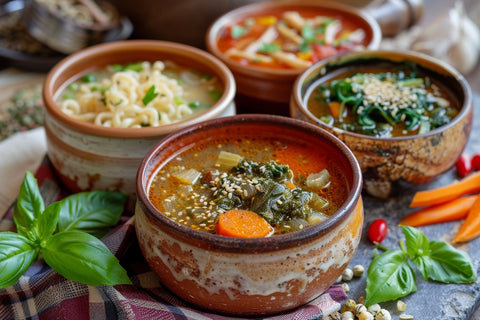Soups in Healthy Eating: Are They Necessary, and Which Soups to Eat

Soups are traditional meals in numerous world cuisines. They are appreciated for their taste and typically, a couple of decades ago, soups were considered the best dietary meals. Yet, times are changing, and today, nutritionists do not consider soups to be a salvation for healthy eating. Let’s get into details about what soups are, which of them are useful for our bodies, and whether there are any cons about them.
What nutritionists say about soups
Typically, soups are dishes which consist of at least 50% of water. In the past, people often cooked soups to nourish big families. At that time, eating soups was a must and they were considered to be the basis of a healthy daily menu. Yet, is it so?
Today, nutritionists are not insisting on making soups the basis of healthy eating. Moreover, earlier, soups were considered to be great prophylactics for gastritis and other digestion issues. They also were taken by numerous diets. Yet, here are two contradictory opinions about this type of dish.
- On one hand, soups are typically made of boiled vegetables and water. Protein can be added to the recipe but it’s not an obligatory option. As a result, when you eat soup, you consume more liquid in the form of broth and boiled vegetables. That refers to healthy eating. Moreover, in 2020, the research summarized that soups have inversive correlation with obesity risks.
- On the other hand, often soups are made using fatty oils, and techniques of sauteing, frying, or baking. If it is a soup cooked with fatty meat loaves or fried vegetables with pasta, it’s not a rescue from gastritis, instead, it can even provoke digestion malfunctions!
So, if summarizing the pros and cons of soups, they may be as follows:
The positive impacts of eating soups are as follows:
- They provide you with the necessary amount of liquid.
- They provide a faster feeling of satiety while you eat fewer calories.
- Soups are great for people who suffer from swallowing issues.
- At last, they are tasty and diverse!
As for cons, they are basically about the technique of cooking. If you cook soups using fatty ingredients, you fry vegetables before adding them to the broth, and you use lots of fats, this soup is not healthy.

Eating soups: is it a tradition or a must for HLS?
As for the essence of soups and stews, they were traditionally used in various cultures as the simplest way to feed a family. Soups are cost-saving as you use less meat or fish, and fewer vegetables than if you cook them as the first course with protein and garnish. That’s why people developed numerous soup recipes around the world like the same minestrone in Italy, bograch soup in Hungary and Ukraine, or Japanese ramen soup and miso soup.
Yet, today, if you love diversity in your meals, and you are a fan of soups, you can easily add them to your menu. It’s OK as eating soup at least 2-3 times a week is good for your digestion and diversifies your gastronomic experience.
Top ideas of healthy soups to add to your healthy eating habits
Of course, soups are very different. Even typical American chowder has hundreds of variations from state to state or even from county to county. The same is true for other soup options worldwide.

If you want to eat healthy soups, we have a couple of ideas, which of them to take.
- Minestrone is a source of vitamins as it is made of various vegetables and olive oil. It can be fully vegan or based on chicken broth.
- Ramen soup and its variations are also healthy. Here we can mention classy Jewish chicken soup with noodles or knedla (balls made of matza), variations of noodle soup with meatballs or fish balls, etc. All of them are tasty and nutritious, and their rich taste is great for cold weather.
- Cream soups based on blended ingredients are also great HLS options. There are diverse recipes including popular squash cream soup, spinach cream soup, French Vichyssoise soup, portobello cream soup, or other soups of that type. Just do not overdo with cream when cooking them, and you’ll get a yummy and light meal.
- Various soups with seafood are great sources of proteins. Here you can taste various types of meals like cult Thai Tom Yum/Tom Kha soup, French bisque, bouillabaisse, traditional clam chowder, or even Suomi fish milk soup.
That’s just a couple of tips you can follow in your strive to eat soups. There are hundreds of great recipes, so do not limit yourself to them. If you want to expand your gastronomic experience and try new tastes of soups, you can do it easily! In 95 Nutrition, we have numerous soup options to select from. Place an order and get your freshly cooked soup with fast delivery from our healthy meal prep and delivery service.